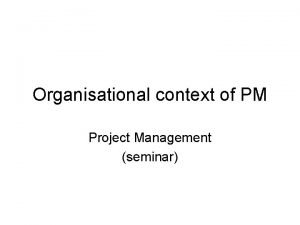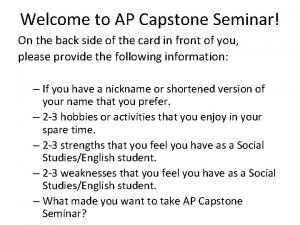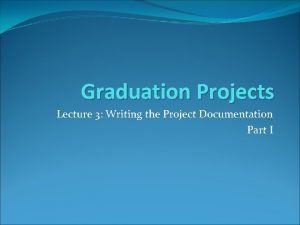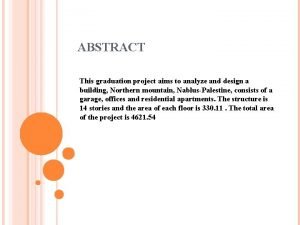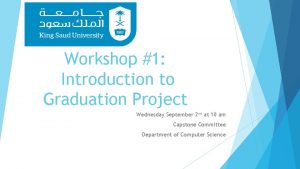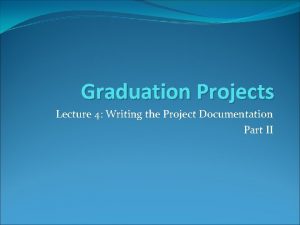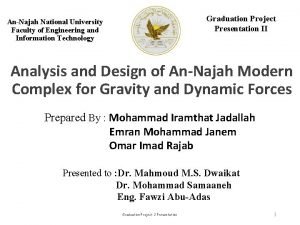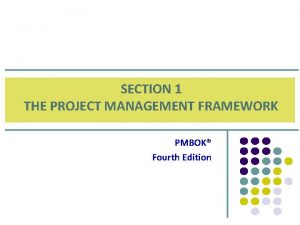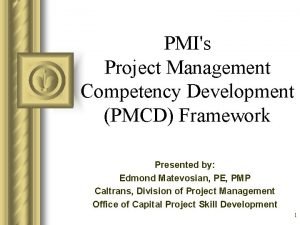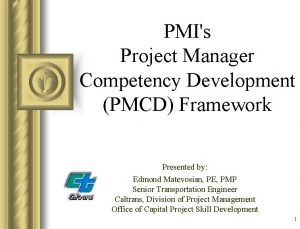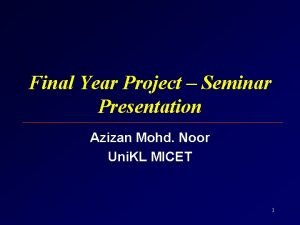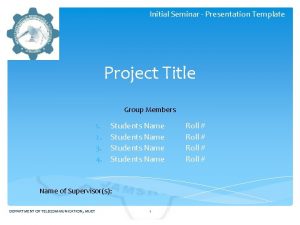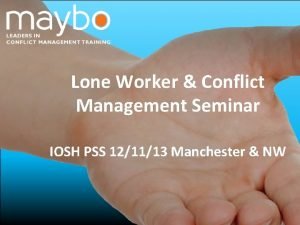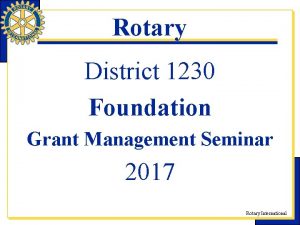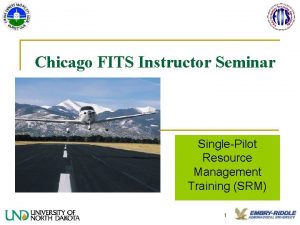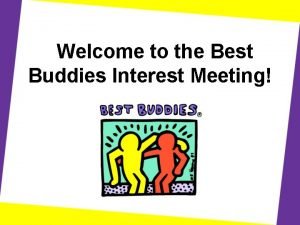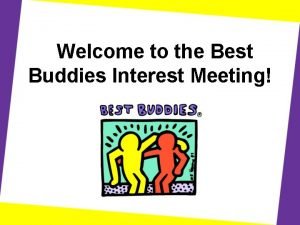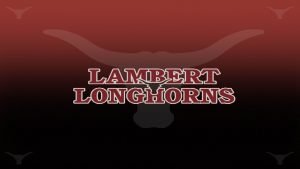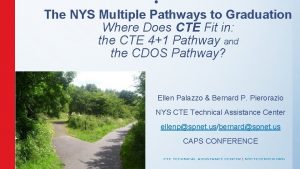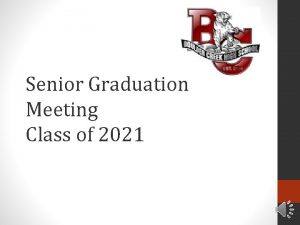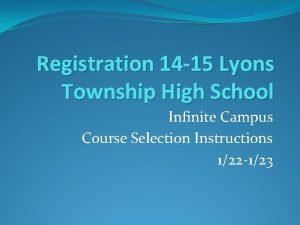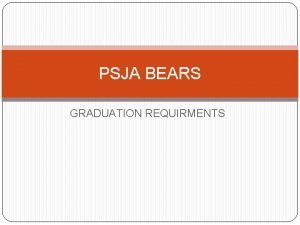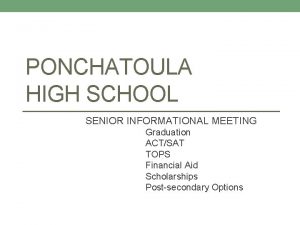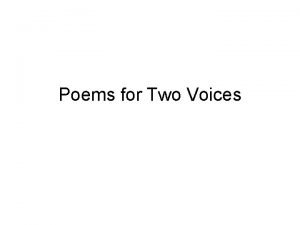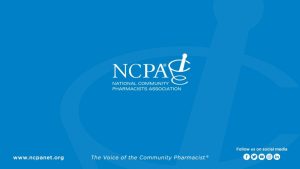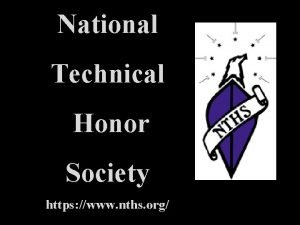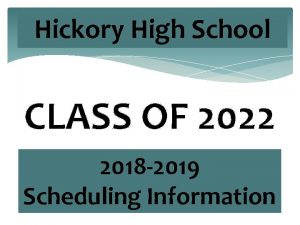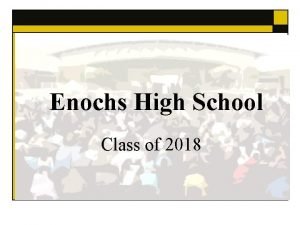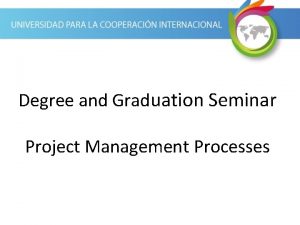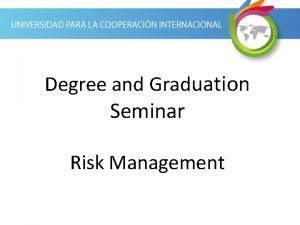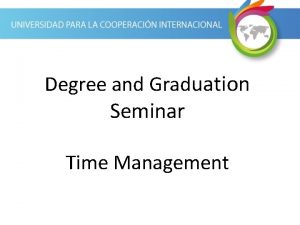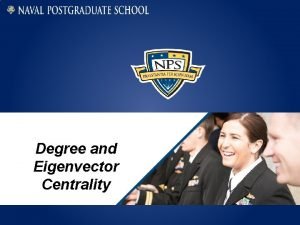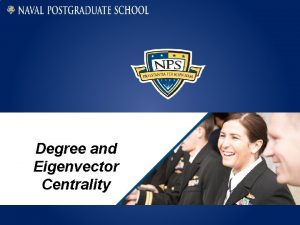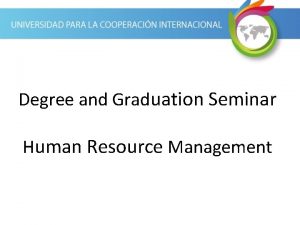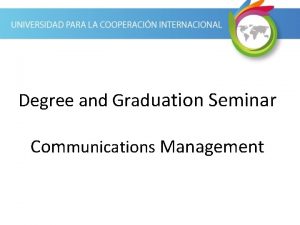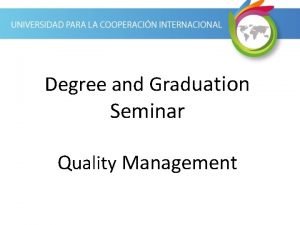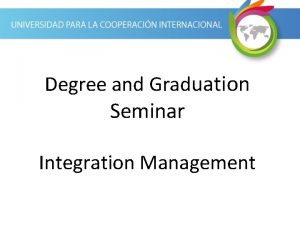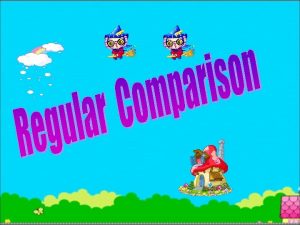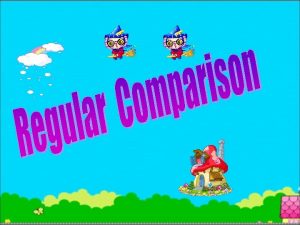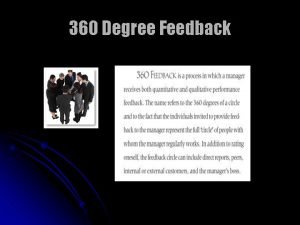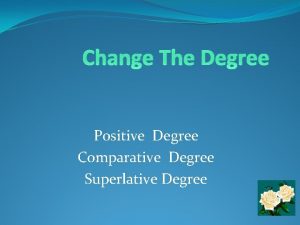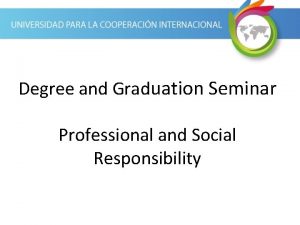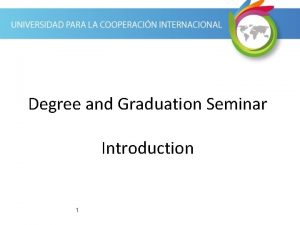Degree and Graduation Seminar Project Management Framework Project



















































- Slides: 51

Degree and Graduation Seminar Project Management Framework

Project vs. Operational work What is a project? A project is a temporary endeavor undertaken to create a unique product, service, or result. What is operational work? Operational work, or operations, are the repetitive, ongoing activities required to sustain a business and achieve its objectives.

Project Temporary: has a start and end Unique: creates a unique product, service or result

Project management • Project management is the application of knowledge, skills, tools, and techniques to project activities to meet the project requirements. 4

Strategic planning and projects Projects can be the actions required to achieve the strategic planning of the company.

Project Management Office (PMO) • A PMO is an organizational entity having various responsibilities related to the centralized and coordinated management of the projects under its domain.

Stakeholders • Stakeholders are people or organizations whose interests may be positively or negatively impacted by the project.

Stakeholder management • Stakeholder management is the process used to manage the expectations of any person or organization whose interests may be positively or negatively impacted by the project.

Stakeholders influence, risk, uncertainty and cost of changes

Organizational structure • Organizational structure is the plan for the systematic arrangement of work, comprising functions, relationships, responsibilities, authorities and communications among individuals within each department. • There are three types of organizational structures: – Project oriented – Functional – Matrix

Functional Organization • A functional organization is a hierarchical organization where each employee has one clear superior, and staff are grouped by areas of specialization and managed by a person with expertise in that area.

Project Oriented Organization • Project oriented organization is any organizational structure in which the project manager has full authority to assign priorities, apply resources, and direct the work of persons assigned to the project.

Matrix Organization • In a matrix organization, the power is shared by the functional manager and the project manager. If the power leans towards the project manager, it is a strong matrix, if it leans towards the functional manager it is a weak matrix. If the power is evenly shared, it is a balanced matrix. • There are three types of matrix organization: • Strong matrix • Balanced matrix • Weak matrix

Strong Matrix Organization • A strong matrix organization is a type of organizational structure where functions have less priority and power rests with the project managers.

Weak Matrix Organization • A weak matrix organization is a type of organizational structure where functions have a higher priority and power rests with the functional managers.

Balanced Matrix Organization • A balanced matrix organization is a type of organizational structure where functions and projects have the same priority.

Tight Matrix Organization • A tight matrix refers to locating the offices for the project team in the same room. It has nothing to do with a matrix organization.

Project Expediter • Project expediter is a role that acts primarily as a staff assistant and communications coordinator, who cannot make or enforce decisions.

Project Coordinator • A project coordinator is a type of role similar to the project expediter, except that the coordinator has some power to make decisions, some authority and reports to a higher level manager.

Some tips to remember: • Functional = independent departments • Project oriented = no “home” at the end of the project • Matrix = 2 bosses

Project objectives – Should be defined at the beginning of the project – Included in the plan – PM responsibility – Must be SMART (specific, measurable, achievable, realistic, time-bound)

Constraints • Constraint is a state, quality, or sense of being restricted to a given course of action or inaction. An applicable restriction or limitation, either internal or external to a project, which will affect the performance of the project or a process.

Program A program is a group of related projects, managed in a coordinated way, to obtain benefits and control not available from managing them individually. 23 04/01/2022

Portfolio A portfolio is a collection of projects or programs and other work that are grouped together to facilitate effective management of that work for meeting strategic business objectives. 24 04/01/2022

OPM 3 • OPM 3 is PMI’s organizational project management maturity model, designed to help organizations determine their level of maturity in project management.

Management by Objectives (MBO) • MBO is a management philosophy with three steps: 1. Establish unambiguous and realistic objectives; 2. Periodically evaluate if objectives are being met; and 3. Implement corrective action.

Lessons learned • Lessons learned is the experience gained from the process of performing the project, both positive and negative.

Sample Question • You are a public executive working on your fourth project to order new buses for a transportation route between 2 cities. You include a government official as a stakeholder and plan to include meetings with him in the WBS. Your manager objects to such activities as unnecessary. The BEST response is to inform your manager that: – A. The government official can negatively impact the project. – B. The government official knows the end-users better than any of us. – C. The government official is a stakeholder since the buses will be used in his city. – D. The government official is a stakeholder because he will be using the buses.

Sample Question • All of the following are parts of the team's stakeholder management effort EXCEPT: – A. Giving stakeholders extras. – B. Identifying stakeholders. – C. Determining stakeholders' needs. – D. Managing stakeholders' expectations.

Sample Question • You are the project manager for your organization. Influencing your organization requires which of the following? – A. An understanding of the organizational budget. – B. Research and documentation of proven business cases. – C. An understanding of formal and informal organizational structures. – D. Positional power.

Sample Question • An organization is going through an evolutionary phase of restructuring the way it does projects. In a shift from a weak matrix organization to a strong matrix organization, the power is shifted from the: – A. Project manager to the functional manager. – B. Expediter to the coordinator. – C. Functional manager to the project manager. – D. Functional manager to the sponsor.

Sample Question • Which form of organization retains many characteristics of a functional organization and treats the project manager’s role as more of a coordinator or expediter than a manager? – A. Project oriented. – B. Functional. – C. Strong matrix. – D. Weak matrix.

Sample Question • A form of project organization where power is evenly shared between the functional manager and the project manager is called: – A. A tight matrix. – B. A weak matrix. – C. A balanced matrix. – D. A strong matrix.

Sample Question • A project manager is trying to complete a software development project, but cannot get enough attention for the project. Resources are focused on completing process-related work and the project manager has little authority to properly assign resources. What form of organization must the project manager be working in? – – A. Functional. B. Matrix. C. Expediter. D. Coordinator.

Sample Question • Who has the MOST power in a project oriented organization? – A. The project manager. – B. The functional manager. – C. The team. – D. They all share power.

Sample Question • A manager and the head of engineering discuss a change to a major work package. After the meeting, the manager contacts you and tells you to complete the paperwork to make the change. This is an example of: – A. Management attention to scope management. – B. Management planning. – C. A project expediter position. – D. A change control system.

Sample Question • A project is managed by a project coordinator. Which of the following statements is most likely to be true? – A. The performing organization is a weak matrix. – B. The performing organization is doing "management by projects". – C. The performing organization is a strong matrix. – D. The performing organization is project oriented.

Sample Question • Being told to complete the project in 3 months using only 4 resources is an example of: – A. Constraints. – B. Earned value analysis components. – C. Benefit cost ratios. – D. Law of diminishing returns.

Sample Question • An advisor to a new project manager tells the project manager to create lessons learned at the end of a project. What does lessons learned include? – A. Variances and their causes. – B. Reports from the customer. – C. Reports from management. – D. All the plans used in the project.

Sample Question • A project is: – A. Temporary and unique. – B. Repetitive work. – C. Work that can be accomplished in 40 hours or less. – D. Work required to sustain a business.

Sample Question • The skills required for effective project management include knowledge of standards and regulations, understanding the project environment, and: – A. Application area knowledge. – B. Engineering knowledge. – C. Software knowledge. – D. Financial knowledge.

Sample Question • A project manager is completing the WBS with the project team, but the session is hard to manage. There are 200 people in the room representing 4 different departments. Some of the people who will be working on the project later are talking about other things while earlier work is discussed. Which of the following BEST describes the real problem? – A. The project sponsor should be leading this kind of meeting. – B. They are not following the project communications management plan. – C. There are too many departments involved in the project. – D. The project manager is really managing a program.

Sample Question • You are a member of your company's project office. The company is running many concurrent projects; most of them share a resource pool. Understanding how resources are utilized across projects is seen as being essential to cost effectiveness and profitability. You recently received an inquiry to assess the benefits of using project management software to manage the company's project portfolio. Which of the following is true? – A. Project management software has the capability to help organize resource pools. – B. Supporting project portfolio management is not the project office's business. – C. Evaluating project management software is not the project office's business. – D. Project management software will dramatically simplify the task of leveling resources across projects with different project management teams.

Sample Question • The policies, methodologies, and templates for managing projects within the organization should be supplied by the: – A. Project sponsor. – B. Functional department. – C. Project management office. – D. Project manager.

Sample Question • The compilation of all the phases within a project equates to: – A. The project life cycle. – B. The product life cycle. – C. Project completion. – D. Product completion.

Sample Question • The previous project manager for your project managed it without much project organization. There is a lack of management control and project deliverables are not clearly defined. Which of the following would be the best choice for getting your project better organized? – – A. Adopt a lifecycle approach to the project. B. Develop lessons learned for each phase. C. Develop specific work plans for each work package. D. Develop a description of the product of the project.

Sample Question • You are the CEO of a large publishing house and want to improve project management practices in your company. What is the BEST thing to do in order to manage the publication of each issue? – A. Clearly define the work to be supplied by other companies. – B. Retain the functional organizational structure. – C. Set up a project office. – D. Identify all the stakeholders for the project.

Sample Question • The Organizational Project Management Maturity Model (OPM 3) addresses: – A. An examination of an enterprise’s project management process capabilities. – B. A standard practice for project management. – C. A standard practice for program management. – D. A standard practice for portfolio management.

Sample Question • Project team members are most likely to work full-time on a project in which of the following organizational structures? – A. Weak matrix. – B. Strong matrix. – C. Tight matrix. – D. Project oriented.

Sample Question • A project may end for all of the following reasons EXCEPT: – A. It is determined that the objectives cannot be met. – B. The project objectives have been met. – C. The need for the project no longer exists. – D. The project manager has left the company.

Bibliography • Project Management Institute. (2013). A Guide to the Project Management Body of Knowledge (PMBOK®) (5 th Ed. ). Pennsylvania, United States of America: Project Management Institute. • Mulcahy, R. (2013)( PMP Exam Prep. (8 th Ed). United States of America: Mc. Graw-Hill.
 Project management seminar
Project management seminar Quest framework ap seminar
Quest framework ap seminar High school graduation powerpoint template
High school graduation powerpoint template Graduation project report example
Graduation project report example Abstract for graduation project
Abstract for graduation project Introduction for graduation project
Introduction for graduation project Graduation project documentation
Graduation project documentation Graduation project documentation
Graduation project documentation Ribbed slab
Ribbed slab Final project bachelor degree
Final project bachelor degree Traditional vs modern project management
Traditional vs modern project management Theoritical framework example
Theoritical framework example Enterprise environmental factors in project management
Enterprise environmental factors in project management Project management competency development framework
Project management competency development framework Pmcd framework
Pmcd framework Final year project presentation
Final year project presentation Seminar presentation template
Seminar presentation template Define seminar in nursing management
Define seminar in nursing management Performance management seminar
Performance management seminar Conflict management seminar
Conflict management seminar Rotary grant management seminar
Rotary grant management seminar Atlweather
Atlweather Dispositional framework vs regulatory framework
Dispositional framework vs regulatory framework Climate change theoretical framework
Climate change theoretical framework Theoretical framework
Theoretical framework Dispositional framework vs regulatory framework
Dispositional framework vs regulatory framework Conceptual framework vs theoretical framework
Conceptual framework vs theoretical framework Windermere high school principal
Windermere high school principal Best buddies graduation cords
Best buddies graduation cords Best buddies graduation cords
Best buddies graduation cords Basha bookstore
Basha bookstore Lambert high school counseling
Lambert high school counseling Hanahan middle school dress code
Hanahan middle school dress code Wasilla high school graduation 2022
Wasilla high school graduation 2022 Nycte
Nycte Agenda for graduation meeting
Agenda for graduation meeting Graduation is just the beginning
Graduation is just the beginning Lths parent portal
Lths parent portal Psja bears graduation 2022
Psja bears graduation 2022 Ponchatoula high school graduation
Ponchatoula high school graduation Poems for two voices
Poems for two voices Ncpa graduation cords
Ncpa graduation cords Nths.org
Nths.org Math mystery case of the graduation gremlins
Math mystery case of the graduation gremlins Lausd graduation cords
Lausd graduation cords Indiana high school graduation requirements 2023
Indiana high school graduation requirements 2023 Hickory high school graduation 2022
Hickory high school graduation 2022 Paragraph
Paragraph Graduation write-up examples
Graduation write-up examples Fbisd graduation
Fbisd graduation Enochs high school graduation 2020
Enochs high school graduation 2020 Episd graduation requirements
Episd graduation requirements
